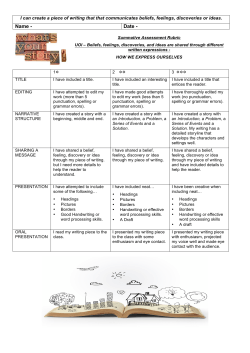
Year 3 Spelling, Punctuation and Grammar
Spelling, Punctuation & Grammar: Planning and Assessment from National Curriculum: Lower Key Stage 2 Steps 22 to 24 Step Step 21 Typical attainment time must have been Stars routinely required attained 22, Entering Y3 Autumn Y3 2 Spelling 23, Developing Y3 Spring Y3 7 VGP 5 Spelling Total Stars (34)* 5 KPIs 24, Secure Y3 Summer Y3 22 VGP, including all 7 Spelling underlined KPIs with 3 stars. 14 VGP The 3 divisions within each statement, annotated as stars, are an indication of the depth of pupil understanding, not the number of times observed. The number of stars routinely required for a step to be achieved is given for consistency and moderation purposes. * Total stars includes only half of the Transcription – Spelling stars to take into account that this section continues into Year 4. Year 3 pupils would not typically achieve the spelling statements during their Y3 year. Attainment of the embedded statements would be typical for Year 4 pupils in the summer of Year 4. Transcription - Spelling B P E B P E Vocabulary, Grammar and Punctuation Vocabulary, Grammar and Punctuation continued Revision from Y1 and 2: pay attention to suffixes. Develop their understanding of the concepts set out in English Appendix 2 (Year 3) by: Use further prefixes and suffixes and Word Formation of nouns using a range of prefixes, such as super–, anti–, auto– ; Text Introduction to paragraphs as a way to group related material. Use of the forms a or an according to Headings and sub-headings to aid understand how to add them (English Appendix 1 (Year 3/4)). Spell further homophones. whether the next word begins with a consonant or a vowel (eg, a rock, an open box); Spell words that are often misspelt (English Appendix 1 (Year 3/4)). Place the possessive apostrophe accurately in words with regular plurals [for example, girls’, boys’] and in words with irregular plurals [for example, children’s]. Develop their understanding of the concepts set out in English Appendix 2 (Year 3) by: presentation. Use of the present perfect form of verbs instead of the simple past (eg, He has gone out to play contrasted with He went out to play). Word families based on common words, showing how words are related in form and meaning (eg, solve, solution, solver, dissolve, insoluble). Use the first two or three letters of a Terminology for pupils Use and understand the grammatical terminology in English Appendix 2 (Year 3) accurately and appropriately when discussing their writing and reading (adverb, preposition conjunction, word family, prefix, clause, subordinate clause, direct speech, consonant, consonant letter vowel, vowel letter, inverted commas (or ‘speech marks’)). Sentence Expressing time, place and cause using conjunctions (eg, when, before, after, while, so, because), adverbs (eg, then, next, soon, therefore), or prepositions (eg, before, after, during, in, because of). word to check its spelling in a dictionary. Write from memory simple sentences, dictated by the teacher, that include words and punctuation taught so far. Paragraph Introduction to inverted commas to punctuate direct speech. :B Beginning to P Progressing © STAT Sheffield E Embedded VGP Vocabulary, Grammar & Punctuation Planning & Assessment Grids for Primary School Teachers Page 47 of 87 16 June 2014 B P E
© Copyright 2025














